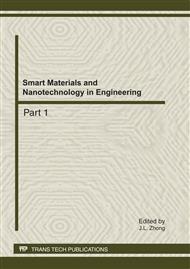p.29
p.35
p.41
p.46
p.53
p.60
p.66
p.70
p.75
Preparation and Characterization of Coenzyme Q10 Powder Micronized by a Rapid Expansion of Supercritical Solution (RESS) Process
Abstract:
Micronized Coenzyme Q10 (CoQ10) is prepared with a rapid expansion of supercritical solution (RESS) process, which does not employ toxic organic solvent. Four factors, namely extraction pressure, extraction temperature, nozzle diameter and precipitation temperature are optimized by a four-level orthogonal array design. The optimum micronization conditions are determined as follows: extraction pressure 25 Mpa, extraction temperature 40°C, nozzle diameter 200 μm, and precipitation temperature 25°C. Under the optimum conditions, micronized CoQ10 with a MPS of 147.9±27.3 nm is obtained. The micronized CoQ10 obtained was characterized by High performance liquid chromatography-mass spectrometry (LC–MS) and High performance liquid chromatography (HPLC) analyses. The results showed that RESS micronization process does not induce degradation of CoQ10 and the obtained CoQ10 particles have higher dissolution rate and solubility compared with unprocessed CoQ10 powder.
Info:
Periodical:
Pages:
53-59
Citation:
Online since:
September 2011
Authors:
Price:
Сopyright:
© 2012 Trans Tech Publications Ltd. All Rights Reserved
Share:
Citation:


